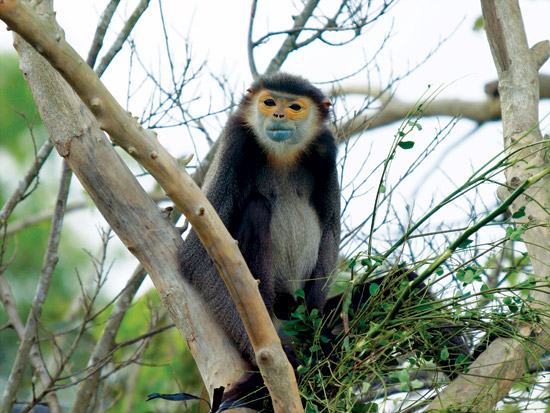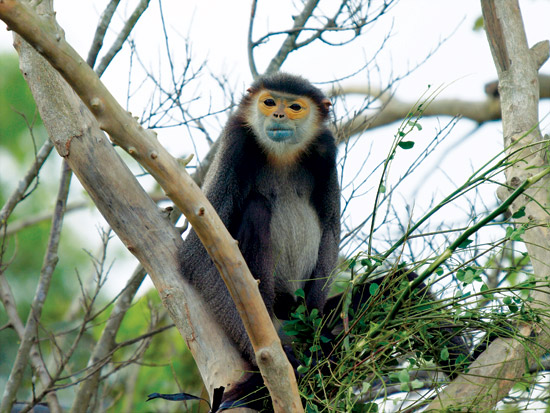(No.10, Vol.1, Dec 2011 Vietnam Heritage Magazine)

On a survey at Ch?a Chan mountain, 100 km northeast off Ho Chi Minh City, in Dong Nai Province in 2010, users of a website about Vietnam’s forest creatures, www.vncreatures.net, discovered a population of 16 of black-shanked douc langurs, scientific name Pygathrix nigripes, including three infants and some that were pregnant.
[A langur is a long-tailed arboreal Asian monkey with a loud call after which it is named (Oxford Dictionary of English Second Edition, 2003) and a douc langur is a langur with black, white and orange fur, native to the tropical rainforests of SE Asia (Concise Oxford English Dictionary Eleventh Edition Revised, 2006)]
The black-shanked douc langur belongs to the Cercopithecidae family. It usually lives in groups of three to 20 in forests 300 metres above sea level on mountain slopes. It breeds once a year, producing one offspring, usually in spring.
The black-shanked douc langur finds food in the morning and afternoon and rests at noon and in the evening. When looking for food – which includes fruit, seeds, leaves, corn, potato, cassava and vegetables – it moves more slowly than the gibbon and is not as quiet in its movements as other species.
The black-shanked douc langur, rated E, for endangered, in the International Union for Conservation of Nature Red List of Threatened Species, has hair on its face and a chestnut-coloured collar. The hair on its forehead and the top of its head is black-grey, there are black-grey areas on its back and the hair at its hips is white, turning black-grey in the groin and opalescent on the tail. Its hair is thick and smooth. Its legs, arms and tail are long, more than 58 centimetres.
The black-shanked douc langur used to be found in many places in Vietnam. Due to hunting and habitat-loss, it has become rare. The Vietnam Red Data Book rates it V, for vulnerable, meaning threatened with extinction. Ch?a Chan mountain has been used for agriculture. In recent years, thanks to government efforts, green has returned and many rare species listed in the Vietnam Red Data Book have bred.
According to the International Union for Conservation of Nature Red List 2011, the black-shanked douc langur has declined more than 50 per cent over its last three generations (30-36 years, based on a generation length of 10-12 years), due to forest-loss and hunting.
The species is found in north-eastern Cambodia and southern Vietnam.
The largest population in Vietnam may be in Núi Chúa National Park, in Ninh Thuan Province. It was estimated at 500-700 individuals by Hoang Minh Duc and Ly Ngoc Sam in 2005.
Hunting was the major threat, according to Nadler et al., in 2003. The species was most often hunted for traditional medicine, mainly by people from the north of Vietnam, where hunting of the black-shanked douc langur was more common. In southern Vietnam, the monkey was primarily sought as a pet.n
Note: Monkey-poachers behind bars
Nguyen Phuong Tuan, 37, and Dang Minh Khac, 20, had been jailed for 12 years in late November by Ninh Hai District Court, in Ninh Thuan Province, in southern central Vietnam, for hunting wild animals, according to Ti?n Phong Newspaper, on 26 November. The two had been charged with catching 15 black-shanked douc langurs in Nui Chúa National Park, in Ninh Thuan Province.
,,
,,

